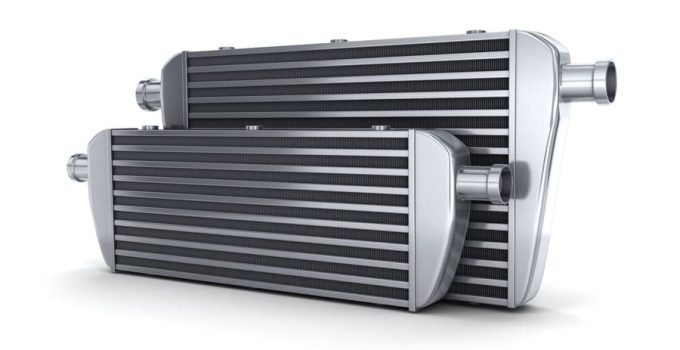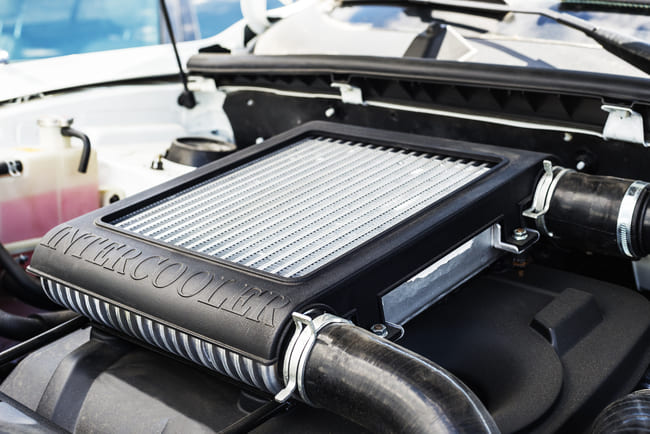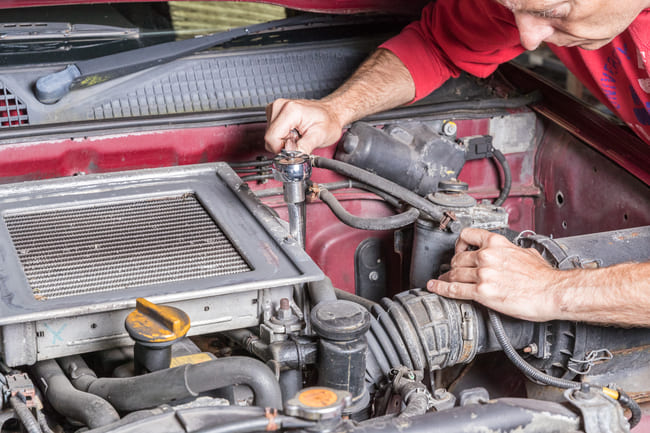
An intercooler increases the performance of your vehicle. In the following article, we will explain not only the function, but also the structure. In general, this system is particularly suitable for vehicles that have a so-called turbocharger. Its main task is to compress the engine air, which is required for combustion. This means that more fresh air can be supplied in a smaller volume, resulting in more engine power. The intercooler is used to further increase performance. Its task is to cool down the fresh air supplied to the engine. This is not normally necessary, however, as it is compressed by the turbocharger, it will heat up. This excess heat reduces the maximum achievable engine performance significantly. Therefore, this component is often used for retrofitting when tuning. The following article will not only give you an understanding of how this component works, but will also explain what happens if the intercooler is defective.
Contents
What is an intercooler?

To begin with, it is important to understand what this component actually is. This component was specially developed for turbocharged engines. This component uses the principle of the heat exchanger. In addition to universal charge air coolers, there are also special components for specific vehicles or engine models. Due to their performance, water-cooled intercoolers are particularly in demand. But first things first:
This type of cooler supports the function of the turbocharger. Its main task is to bring more oxygen into the combustion chambers for the combustion process of the fuel in the smallest possible volume. In this way, more energy can be released within the corresponding stroke and the exhaust gas expansion, which generates the piston stroke, is increased. But how can the turbocharger improve the oxygen supply to the engine? This is very easy to do, because air is a gas that can be compressed very well. As a result, the volume of the air (and thus also the oxygen it contains) is reduced many times over. So „fit“ finally more oxygen molecules at the same time in the combustion chamber and also the volume of the finally injected fuel can be proportionally increased.
However, a serious disadvantage of this compression of the air is that the compression leads to a significant heating of the charge air (or fresh air). This in turn has the consequence that the engine efficiency decreases, because the maximum efficiency of a heating machine always depends on the prevailing temperature difference. This is exactly where the intercooler comes into play. If you have installed such a component in your vehicle, the compressed air will be significantly cooled down again by heat exchange processes. Thus, the efficiency of your engine is increased again and the engine performance reaches new peak values. However, you should always look out for symptoms of a leaking intercooler.
Air-cooled and water-cooled charge air coolers
In principle, two different types of these components are used today: These include the simpler air-cooled charge air cooler. In most cases, these have an aluminum cooling network, which, due to the huge surface area, leads to heat transfer and thus cooling. The special coolers from the tuning area are examined and optimized with regard to the exact flow behavior. This allows the charge air to be cooled down as effectively as possible without generating too much pressure loss.
The second type is water-cooled intercoolers with higher performance. Normally, these are not cooled via the normal cooling system, but have a completely separate cooling circuit with the corresponding heat exchangers. Their performance is sufficient to cool the intake air by up to 30°C. With the same charge air pressure, this corresponds to an engine performance increase of about 10%.
Cleaning and flushing your charge air cooler

Part of the maintenance of this important intake component is to flush this component regularly. The cooling performance can decrease significantly over time if this component is not cleaned. For this process, you must first remove the component. You can find a more detailed description of this in any good vehicle-specific repair manual. In general, the following procedure is sufficient: Unscrew and remove the grille, Dismantle the bumper and the engine cover. Remove bumper support and detach headlight power supply. Remove the hood bowden cable and the front mask. Then remove all screws, connections and hoses. You should first place a suitable container under the component. After separating the intercooler and oil cooler, you may have to drain the oil first. You should then be able to remove the intercooler for rinsing. For actual cleaning, both acetone and brake cleaner are suitable. Before reinstalling it, it is extremely important to ensure that this component no longer contains any liquids and that the brake cleaner or acetone has evaporated without leaving any residue. The reassembly is then to be carried out in the reverse order. Your engine also requires appropriate care, so that an engine flush can sometimes make a big difference.
How do you improve the function of your intercooler?
In addition to regular cleaning, there are other ways to optimize functionality. In the end, it's always about increasing the amount of coolant; i.e. allowing more air to flow through air-to-air coolers. In some cases, this can be achieved with the standard intercoolers by modifying them, for example by ensuring that the warm air cannot accumulate behind the cooler or that it is better supplied with air. In most cases, TÜV approval is required. An alternative is to replace it with a better system. However, you should always keep in mind that increasing the component volume leads to lower intake air temperatures, but at the same time the achievable charge air pressure also decreases.
Conclusion
Tuning fans can hardly do without a reasonable water-cooled intercooler. It is good that such a component can often be retrofitted without any problems. There are also some universal intercoolers available. Some of these can also be installed yourself with a little more know-how. Otherwise, we recommend that you visit a specialist workshop, which can also advise you on the appropriate components. In most cases, however, what is known as chip tuning is the first step in tuning your engine performance. You should note that your vehicle is then more suitable for moderate climate zones.
A tip from CarTipsandmore: An intercooler offers you a number of other advantages in addition to increased engine performance. This includes, for example, putting less thermal stress on your pistons, which increases engine life. Incidentally, the same also applies due to the reduced charge air temperature. This ensures that there is less engine knocking. This protection also increases engine life.
